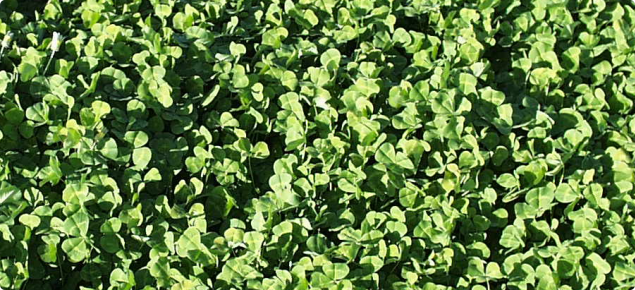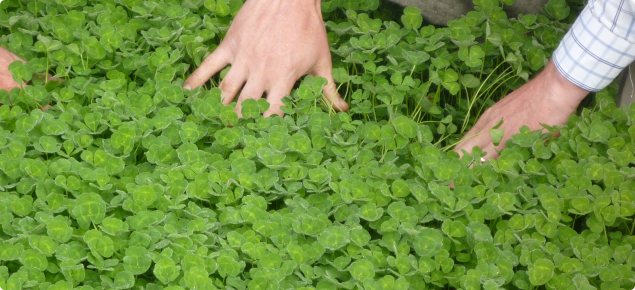A range of cultivars are available for areas ranging from 275 to 1200 millimetre (mm) annual average rainfall. Subspecies subterraneum is adapted to well-drained, moderately acidic soils. Subspecies yanninicum is suited to moderately acidic soils with poor drainage. Subspecies brachycalycinum is best suited to neutral-alkaline, cracking or stony soils and generally fails to persist in WA.
Use of subterranean clover
Subterranean clover (Trifolium subterraneum L.) is the most widely sown annual pasture legume in southern Australia. It is estimated to have been sown over an area of eight million ha in Western Australia (WA) and 29 million ha across southern Australia. Together with the use of superphosphate, subterranean clover has led to increased crop yields and greater animal production. It forms the basis of many permanent or semi-permanent pastures in high rainfall and irrigated areas. In low and medium rainfall areas it is commonly grown in rotation with cereal crops, although it is poorly adapted to intensive crop rotations, such as 1 pasture:1 crop. Its ability to fix atmospheric nitrogen (N) benefits growth of other species in the pasture and of following crops grown in rotation.
Subspecies
Subterranean clover has three subspecies (ssp):
- ssp. subterraneum (sometimes referred to as “black-seeded” types), adapted to well-drained, moderately acidic (pHCa 4.5-6.5) sandy-loam to loamy clay soils.
- ssp. yanninicum (sometimes referred to as “white-seeded” types, due to their cream-amber coloured seeds), adapted to poorly drained, moderately acidic sandy loam to clay soils.
- ssp. brachycalycinum, best suited to neutral-moderately alkaline (pHCa 6.0-8.0) cracking or stony soils.
Subspecies subterraneum is the most widely sown and has the most cultivars, while ssp. brachycalycinum generally fails to persist on WA soil types.
Features of subterranean clover
Subterranean clover is the most grazing tolerant pasture legume and has several features that make it well adapted to the farming systems of WA and southern Australia:
- It has an annual life cycle and grows from autumn to spring, which matches the time that most rainfall occurs.
- It regenerates naturally from seed set in previous seasons, without the need for re-sowing.
- It maintains a seed bank of ‘hard’ seeds, in which some seeds remain dormant for germination in later years, enabling regeneration after cropping or a year of little or no seed-set.
- It tolerates regular, close grazing (particularly set-stocking by sheep), due to its prostrate growth habit.
- It buries its burrs to protect seeds from being eaten by stock (particularly spp. subterraneum and yanninicum).
Origin of Australia’s subterranean clovers
Subterranean clover is not native to Australia, but occurs naturally in the Mediterranean basin and surrounding areas. It was accidentally introduced into Australia in the 19th century by the early settlers and was first commercialised in the early 1900s. Cultivars are derived from three main sources:
- accidental introduction from other countries, followed by colonisation and development of local types, known as ‘naturalised strains’
- deliberate collection of seeds from the Mediterranean region and surrounding areas
- breeding programs, involving crossing and selection of types with desirable traits.
To date 53 cultivars have been registered in Australia, although many are now out-dated. Most of the recent cultivars have been developed from breeding programs. The Department of Agriculture and Food, Western Australia (DAFWA) has released the most cultivars, with others released by the South Australian Research and Development Institute (SARDI) and by Italian researchers. Other varieties that have not been registered with the Australian Seeds Authority are also on the market.
Cultivar development has been aided by a large genetic resource of around 10 000 types that have been collected from its native habitat and naturalised strains from Australia. Identification of cultivars is based on variation in attributes (for example colour, hairiness) of the leaf, petiole, stipule, runner, flower and seed.
Choosing the right cultivar
Tables 1 and 2 show agronomic data for ssp. subterraneum and ssp. yanninicum cultivars suitable for use in WA, while Table 3 shows data for ssp. brachycalycinum cultivars. Outdated cultivars and brands not registered with the Australian Seeds Authority are excluded. The following factors should be considered when choosing the most appropriate cultivar for sowing.
Subspecies
Select the best adapted subspecies for the paddock to be sown. A mixture of subterraneum and brachycalycinum subspecies may be appropriate for paddocks with variable drainage.
Flowering time
Flowering time is the most important character that determines cultivar persistence in an environment, as it determines the amount of seed that can be set. The most appropriate flowering time is a balance between producing high quantities of feed, and setting high levels of seed. Later flowering cultivars produce more spring feed, whereas earlier flowering ones can set more seed before the summer drought. Low rainfall, short growing-season environments require early flowering cultivars for persistence, whereas high rainfall, long growing-season environments should be sown to later flowering cultivars.
Mixing two or more cultivars with up to two to three weeks flowering time difference is one way to account for seasonal differences. Earlier flowering cultivars will set seed in seasons that finish early, while later flowering cultivars will be able to take advantage of favourable seasons.
Oestrogen levels
Some older cultivars contain high levels of the compound, formononetin, which can cause infertility and difficult birthing in ewes. All newer cultivars have been selected with formononetin levels ≤ 0.2% of dry matter, giving them a low potential for oestrogenic problems. Two other less important oestrogenic compounds, genistein and biochanin A, are also present in subterranean clover, but are of less concern to graziers.
Hardseededness
Cultivars vary in the proportion of seeds that remain hard (dormant) in the winter following seed set. Cultivars for lower rainfall areas and those used in crop rotations need to be hardseeded, to enable them to regenerate reliably after a year of little or no seed set. For example, the greater hardseededness of the new cultivars Tammin and Forbes allow them to persist better through crop rotations than less hardseeded cultivars. On the other hand, higher rainfall environments need less hardseeded cultivars, as their seasons tend to be more reliable. In these areas seedling germination needs to be high to enable subterranean clover to compete with other pasture components.
It should be noted that most subterranean clover cultivars are among the least hardseeded of the annual pasture legumes. This means they are poorly adapted to intensive crop rotations, such as 1 pasture:1 crop. The new, more hardseeded cultivars, Tammin and Forbes, are better adapted, but other more hardseeded species, such as biserrula (Biserrula pelecinus), bladder clover (Trifolium spumosum), yellow serradella (Ornithopus compressus) and annual medics (Medicago species) are well suited to such rotations.
Disease resistance
Several diseases can affect subterranean clover, particularly in high rainfall areas. Clover scorch, caused by the fungal pathogen Kabatiella caulivora, is the most important leaf disease. Two races are known, with Race 1 being the most widespread and Race 2 being confined to the Esperance sand plain. Most of the newer cultivars aimed at medium and high rainfall areas have some resistance to both races. A range of other leaf diseases can affect subterranean clover, including leaf rust (Uromyces trifolii-repentis), powdery mildew (Erysiphe polygonii) and leaf spots caused by Cercospora zebrina and Pseudopeziza trifolii. Screening of advanced breeding lines is conducted to ensure cultivars released onto the market are not highly susceptible to these diseases. Several fungi cause root rots of subterranean clover. Of these Phytophthora clandestina is the most important and screening has been conducted to select cultivars with some resistance to the most important races. A range of viruses can also affect subterranean clover.
Redlegged earth mite resistance
Redlegged earth mites (RLEM), Halotydeus destructor, are the major pest of subterranean clover, particularly at the seedling stage. All older cultivars are susceptible to RLEM as seedlings. However, the new cultivars, Rosabrook, Narrikup, Bindoon, Tammin and Forbes, have been released with increased cotyledon resistance to RLEM. Field studies have shown these cultivars have higher seedling densities in regenerating pastures than similar older cultivars, resulting in increased autumn-winter production. However, the resistance is not absolute and pesticides should be used at sowing to ensure good establishment and in regenerating pastures when RLEM densities are high.
Cultivars
The below tables show agronomic data for subterranean clover cultivars currently under (or in the process of obtaining) Plant Breeders Rights in Australia.
Outdated cultivars and brands not registered with the Australian Seeds Authority are excluded. Data are for an early May sowing in Perth. All listed cultivars have low oestrogen levels.
Key:
- Hardseed rating: 1=least hard, 10=most hard.
- Resistance rating: highly susceptible=HS, susceptible=S, moderately susceptible=MS, moderately resistant=MR, resistant=R, highly resistant=HR, no data=nd
| Cultivar | Days to first flowering | Rainfall zone (mm) | Minimum growing season length (months) | Hardseed (0-10) | Clover scorch resistance – race 1 | Clover scorch resistance – race 2 | RLEM cotyledon resistance |
|---|---|---|---|---|---|---|---|
| Izmir | 78 | <375 | 3.5 | 5 | S | MS | S |
| 88 | 300-450 | 4 | 10 | HS | HS | MR | |
| Losa | 98 | 375-500 | 4.5 | 2.5 | S | S | S |
| 101 | 350-525 | 4.5 | 7 | HS | HS | MR | |
| Urana | 103 | 400-600 | 4.5 | 5 | S | MR | S |
| 108 | 425-600 | 5 | 1.5 | HR | HS | MR | |
| Campeda | 123 | 500-700 | 6 | 2.5 | MS | R | S |
| 126 | 500-750 | 6.5 | 1,5 | HR | R | MR | |
| Coolamon | 133 | 500-750 | 6.5 | 2.5 | HR | HR | S |
| 142 | >650 | 7.5 | 2.5 | HR | R | MR |
| Cultivar | Days to first flowering | Rainfall zone (mm) | Minimum growing season length (months) | Hardseed (0-10) | Clover scorch resistance – race 1 | Clover scorch resistance – race 2 | RLEM cotyledon resistance |
|---|---|---|---|---|---|---|---|
| Monti | 110 | 425-600 | 5.5 | 1 | R | nd | S |
| 121 | 450-700 | 6.5 | 2.5 | HR | HR | S | |
| 131 | 550-900 | 7 | 1.5 | HR | HR | S | |
| Napier | 140 | >700 | 7.5 | 2.5 | R | R | S |
| Cultivar | Days to first flowering | Rainfall zone (mm) | Minimum growing season length (months) | Hardseed (0-10) | Clover scorch resistance – race 1 | Clover scorch resistance – race 2 | RLEM cotyledon resistance |
|---|---|---|---|---|---|---|---|
| Mawson | 100 | 350-525 | 4.5 | nd | nd | nd | S |
| Mintaro | 115 | 450-700 | 5.5 | 3 | MS | MS | S |
| Tarlee | 130 | 500-700 | 6.5 | 1 | MR | MR | S |
| Antillo | 136 | >550 | 7 | 1 | MR | MR | S |
| Antas | 138 | >550 | 7 | 1 | HS | HS | S |




